Redwoods and Climate Change
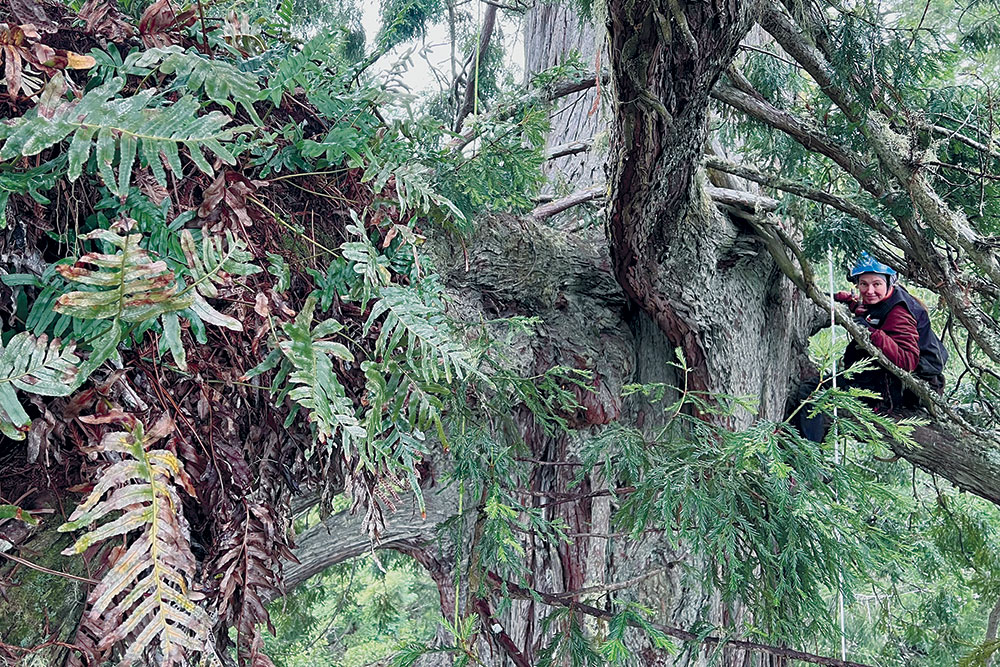
Vulnerability, Resilience, and Hope in the World’s Tallest Trees
By Marie E. Antoine and Stephen C. Sillett, Cal Poly Humboldt
Coast redwood (Sequoia sempervirens) has a narrow and highly fragmented distribution along 460 miles of western North America. Although they occupy only a small land area, primary (unlogged, old-growth) redwood forests are globally renowned. Extreme resistance to fire, fungi, and herbivores allows redwoods to become the tallest trees on Earth and live more than 2,000 years. These same qualities make excellent lumber, and redwoods have been heavily exploited by logging. Less than 5% of primary redwood forests remain (176 square miles), and mature (> 100 years old) secondary forests are even scarcer (42 square miles) because forests are logged repeatedly. Non-timber values like long-term carbon sequestration and biodiversity provisioning warrant closer consideration in this era of environmental disruption.
How Might Redwoods Fare in a Changing Climate, and What Can We Do To Help?
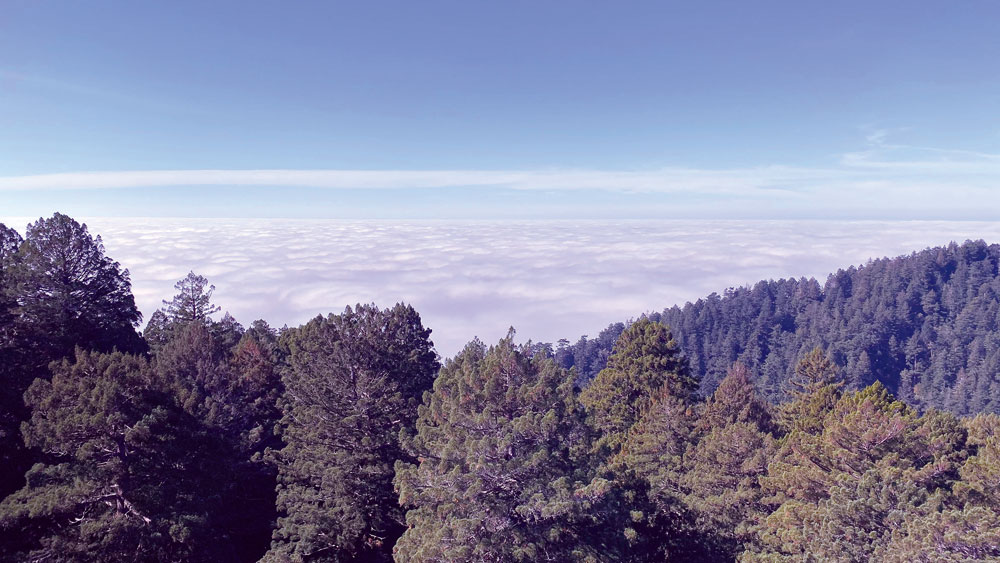
Photo by S. Sillett
To answer these questions, we visited 45 locations (32 primary and 13 secondary forests) from California’s Monterey County to Oregon’s Curry County. We climbed 235 trees, measuring each one from base to top and extracting thin core samples. Redwoods, like other temperate-zone trees, store their growth histories in annual rings, and cores are a non-destructive way to read a tree’s story. We took core samples from trunks at regular height intervals because sampling only near ground level tends to underestimate growth rates (more biomass production occurs within crowns as trees enlarge with age). Overall, we sampled 1.2 million annual rings, which were crossdated by Cal Poly Humboldt dendrochronologist Allyson Carroll. These data were combined with intensive measurements and allometric equations to reconstruct tree size and productivity through time. Redwood performance was modeled as functions of tree attributes, landscape position, and climate. Funding for this work came from Kenneth L. Fisher (Chair in Redwood Forest Ecology at Cal Poly Humboldt) and the Save the Redwoods League (Redwoods and Climate Change Initiative, Phase 3). Our rangewide analysis was recently published in Forest Ecology and Management—526 (2022) 120573. What we learned is cause for both concern and hope.
Which Climatic Variables Affect Redwood Productivity?
Redwood habitat suitability is generally dependent on soil water replenished through rain and fog drip as well as water absorption through foliage. The redwood range spans over 6° of latitude. Rain and summer fog are highest in the north and lowest in the south. Trees north of 40° are least drought-sensitive, making similar biomass in dry and wet years, while trees south of 37° are most sensitive. The extravagantly wet start to 2023 sets an unlikely stage for talking about drought, yet the climatic variable most related to redwood growth is a drought index encompassing both water availability and temperature variability.
Drought sensitivity has recently been increasing throughout the redwood range. Southern trees experience problems earlier during multi-year droughts, and they recover more slowly from extreme drought than northern trees. Across the range, smaller and younger trees in secondary forests experience more growth suppression during extreme drought than larger and older trees in primary forests. In late 2022, when our analysis was published, the whole redwood range was once again in the midst of a multi-year drought. Abundant rain returned to the region in early 2023 with excessive precipitation and extreme winds presenting an entirely different challenge to redwoods.
Regardless of precipitation, the redwood range will experience progressive drying due to global warming. Temperatures are highest in the south, lowest in the north, and rising steadily, especially at night. The drying power of air—vapor pressure deficit (VPD)—increases exponentially with temperature. High daytime VPD means trees need to close their leaf stomata earlier in the day to prevent damaging water loss. This limits photosynthesis, but such “source limitation” is mitigated by rising atmospheric carbon dioxide (CO2) levels. In today’s enriched atmosphere (CO2 currently 419 parts per million, was 317 in 1960), trees can partially close leaf stomata to reduce water loss and still absorb plenty of CO2 for photosynthesis. Nevertheless, heatwaves with extreme daytime temperatures can lead to treetop dieback, and another temperature effect directly inhibits radial growth
of redwoods.
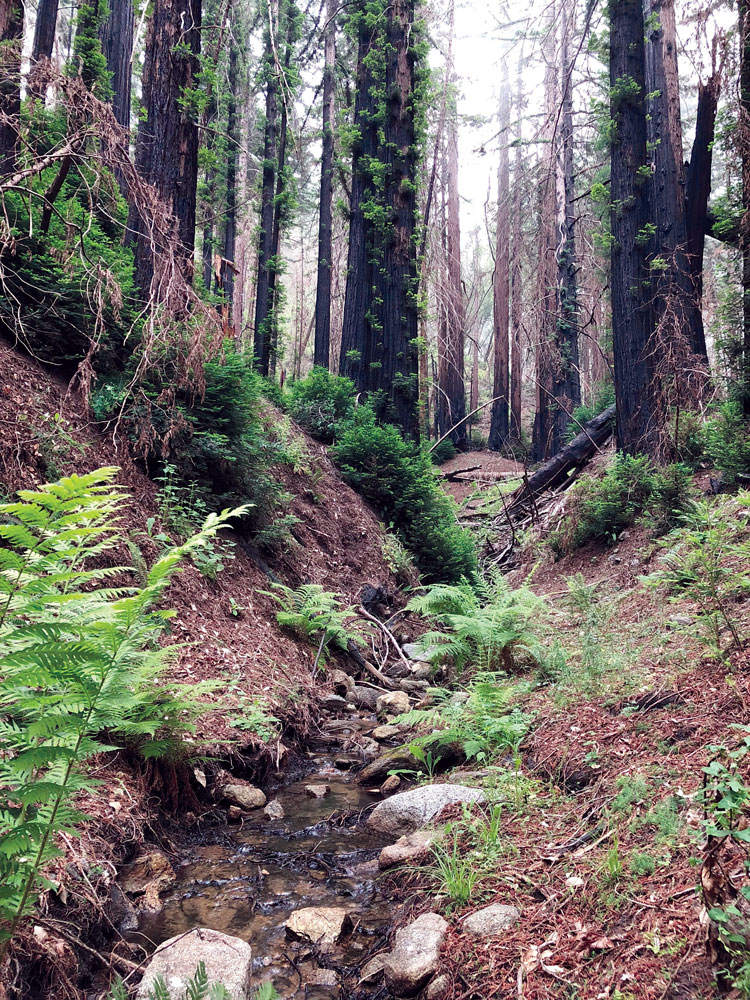
Growing season minimum temperatures are increasing as nights become unusually warm. High nocturnal VPD creates problems in the layer of dividing cells where new wood is made (the cambium). Dry air at night prevents sufficient turgor pressure to develop in the cambium for cell division and enlargement. With this “sink limitation” too few cells are produced to make new wood, so sugar produced by leaves via photosynthesis must be stored or used elsewhere. Where? Roots and mycorrhizal fungi are a definite possibility, though the belowground biology of redwoods remains largely unexplored. Another major sink is indicated by the name of the tree itself—the wood is red because of heartwood chemicals that resist fungal decay. Heartwood fungicide is redwood’s superpower.
Trees strike a balance between making new tissues and protecting them from corruption. We express this balance with the metric “growth efficiency”—the amount of biomass produced annually per unit leaf mass. Sink limitations due to warmer, drier nights reduce growth efficiency but may increase wood quality, because excess sugar is used to make fungicide, not tree rings. Coastal fog helps to lower VPD, and nighttime fog is one of the best predictors of redwood growth efficiency. During multi-year hotter droughts, redwoods in forests lacking sufficient nighttime fog will see the most growth inhibition, but again, their heartwood may become more durable. This could be a silver lining of climate change, though it is more complicated because young and old redwoods aren’t equivalent.
A bigger tree makes more wood annually than a smaller tree because it has more leaves, and the older a redwood gets the greater its annual investment in fungicide. Heartwood production and fungicide investment are both higher in primary than secondary forests throughout the range. This means secondary forests are generally less effective than primary forests at long-term carbon sequestration, and the capacity of regenerating forests to sequester carbon in durable biomass may be overestimated. Considering 95% of current redwood forests are relatively young, the priority is clear—we need more big old redwoods on the landscape.

Elder Trees
Managing redwoods as short-rotation crops squanders the potential of a species that can live for two millennia. Long-term carbon sequestration is one issue, and biodiversity is another. These two non-timber values are interconnected because decay-resistant heartwood creates long-lasting substrates for epiphytes (plants that grow on plants without parasitism), including giant fern mats and ericaceous shrubs in the wettest part of the redwood range. Vascular epiphytes like ferns and shrubs represent an endpoint in epiphyte community development. Tree structural complexity promotes biodiversity—the largest and oldest trees host the bulk of arboreal life in addition to being carbon-sequestration champions. We’ve gotten to know redwoods very well over the past few decades and have come to think of exceptional individuals as elder trees.
We choose the word “elder” with intention both figurative and literal. The word applies figuratively because respect for elders is a cherished value in most cultural traditions worldwide. The literal sense of the word is demonstrated by the data—of 235 study trees only 34 hosted vascular epiphytes, and their average age was over 1,100 years. The biggest, gnarliest, epiphyte-laden trees are precious individuals that deserve all the reverence implied by the term “elder.” With over 95% of redwood forests having been logged at least once, elder trees are now rare on the landscape. This reality becomes starker with each major fire, landslide, or flood event that causes attrition in the last remaining primary forests.
What Can We Do to Help?
We can literally grow hope for the future by designating potential elder trees (PETs). Imagine an approach where some of the most robust individual trees in a secondary forest are chosen to become part of the long-term inventory. These may or may not be trees with the largest trunk diameter. PET selection should also consider crown structure, where trees with the biggest branches and complexity such as limbs and reiterated trunks show exceptional promise. The PET acronym is apt because it conveys the sense of caring we associate with our beloved animal companions. In the case of these special trees, if we tend and nurture them, they will thrive.
Work is underway to establish objective criteria for PET selection. Once PETs are designated, future forest management can be designed to promote their health and vigor, including thinning of crowded tree neighborhoods. Over time, a decreasing number of enlarging trees will produce increasingly durable biomass with some minimum number of PETs gaining full stature and becoming elder trees. With the PET strategy, wood production and non-timber values are not mutually exclusive. While the PET idea is not limited to redwoods, the extreme size and longevity of this species make it ideal for this tree-based approach to forest management.
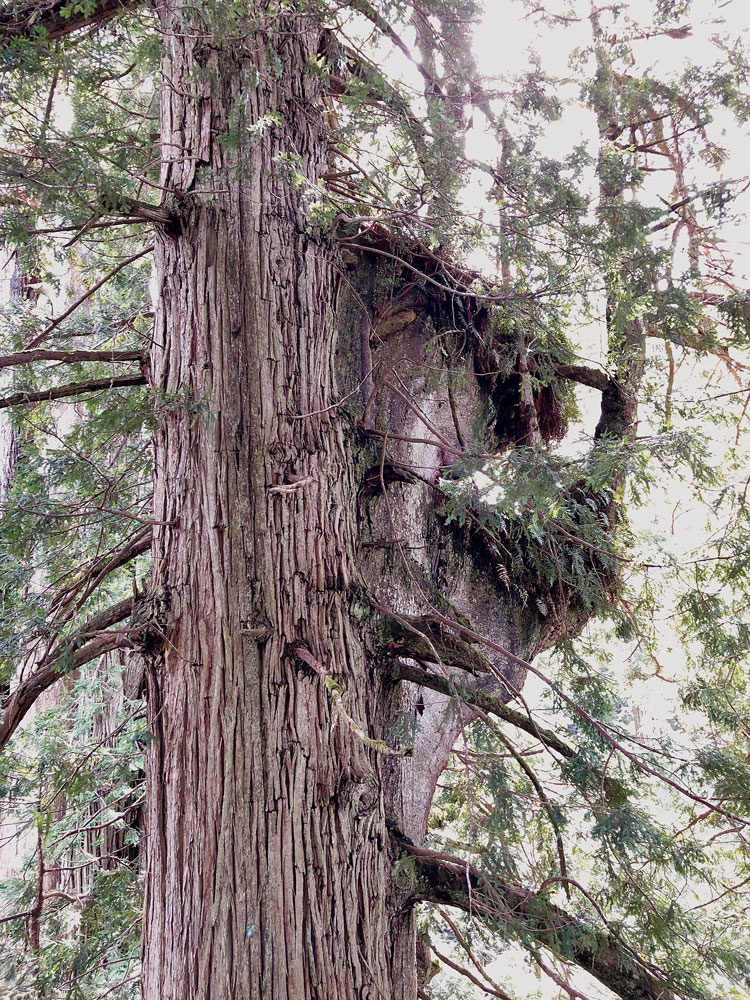
Variability of Redwoods
The variability of redwood—from gallery forests of California’s Santa Lucia Mountains receiving less than 30 inches of annual precipitation to rainforests in southwestern Oregon receiving more than 80 inches, from foggy forests near the immediate coast to isolated canyons 30 miles from the ocean with little marine influence, and from lowland alluvial forests where redwood contributes over 99% of aboveground biomass to coastal montane forests dominated by other species—makes establishing realistic restoration targets across its range difficult.
Where Do We Start?
The PET approach has maximum impact in the northern part of the redwood range because of ecologically important vascular epiphytes. While it’s generally true that crown structural complexity promotes arboreal biodiversity, well-developed epiphyte communities including ferns, shrubs, and canopy soil occur only in elder trees of the wettest and foggiest forests. The northern range also has the most land area occupied by secondary forests with unrealized potential for long-term carbon sequestration. Young trees north of 40° have the highest growth efficiency and lowest investment in heartwood defense. In other words, northern redwoods grow efficiently, but unless they are allowed to grow old, they produce relatively small amounts of low-quality heartwood with little fungicide. Promoting redwood PETs in the northern range will maximize future contributions of long-term carbon sequestration and arboreal biodiversity. Ongoing research shows that development of arboreal biodiversity can be accelerated by transplanting ferns into PET crowns. Even in places where climate doesn’t allow vascular epiphytes, PETs promise benefits such as long-term carbon sequestration, improved fire resistance, and the inspirational value of elder trees.
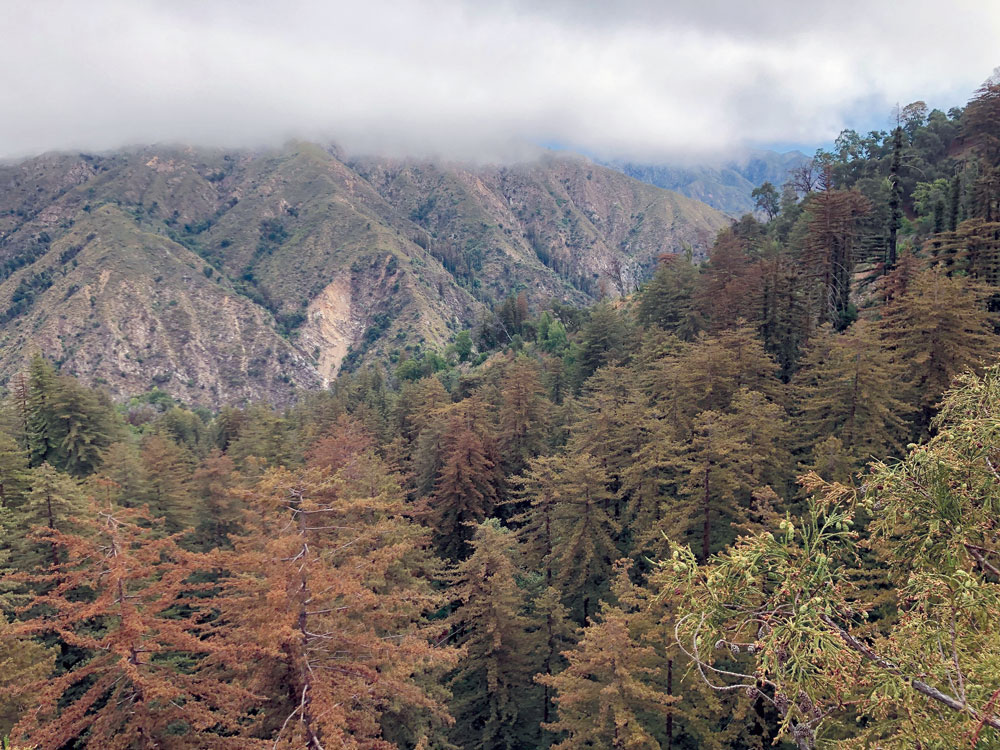
Photo by S. Sillett
In an Uncertain Future
The loss of so many redwoods in recent winter storms highlights the urgency of restoring big old trees to the landscape beyond the few remaining primary forests in parks and reserves. From floods and landslides to fire and drought, extreme events are becoming more frequent. A thriving PET population rangewide would give redwoods their best chance to contribute non-timber values in perpetuity. Realistically, these iconic trees might experience top dieback during extreme daytime temperatures and produce less wood because of higher nighttime temperatures. Hotter droughts and severe wildfires might even cause contraction of the species range near its range margins. However, with thick fire-resistant bark and an amazing capacity for clonal reproduction via sprouting, few tree species are so well equipped to persist in an uncertain future. Our actions now will determine the quality of forests to be enjoyed by generations to come.
The full article, Stephen C. Sillett et al. Rangewide climatic sensitivities and non-timber values of tall Sequoia sempervirens forests. Forest Ecology and Management 526 (2022) 120573, can be found at:
https://www.sciencedirect.com/science/article/pii/S0378112722005679
For more information: [email protected] or [email protected]
